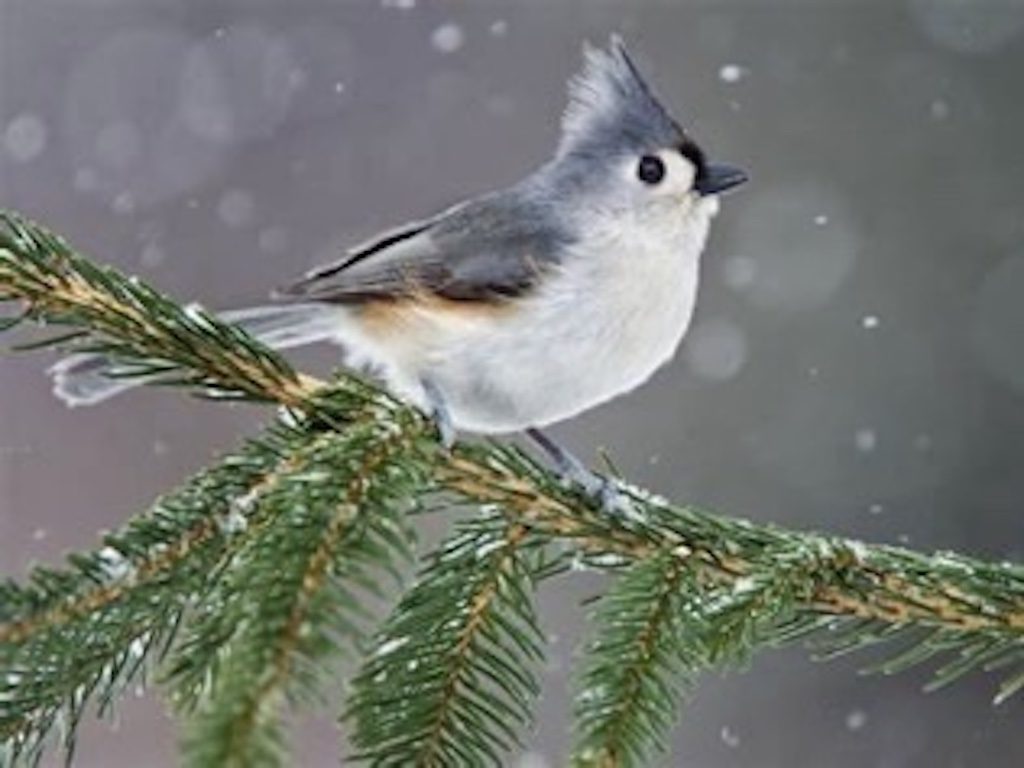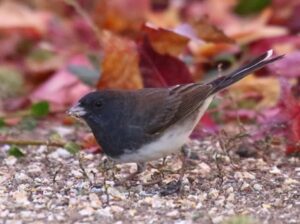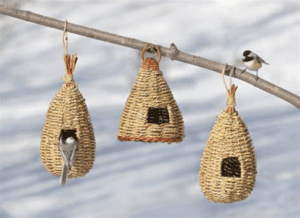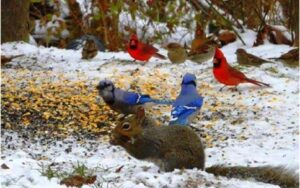Issue 9 | November 2023 | Winter Bird Care

By Bryan Gomes, CSH2O Environmental Educator

As the days continue to get shorter and daylight savings time has come to an end, we begin to look to the winter season and upcoming holidays. But let’s remember those brilliant summer moments when we saw all kinds of feathery fauna—from the majestic osprey diving for fish to the tiny hummingbird visiting our feeders. Although those species have flown south for the winter, those moments can continue through the colder months with many other birds until the days creep longer next spring.
There are many ways to make your backyard conducive to all types of birds. The types of bird feeders, bird seeds, and houses you provide, as well as your lawn and garden habits can influence the habitat you would like to establish. Birds have the same needs of food, shelter, and water in the winter as they do any other time of year; so let’s dive into this information. Now is the time!
Although we have some seasonal chores we do most years, there is something to be said for “less is more” for creating wildlife refuges in our own backyards. Tod Winston, Audubon’s Plants for Birds manager, says, “Messy is definitely good to provide food and shelter for birds during the cold winter months.” Are you familiar with No Mow May (Shark Bites, Issue 7, May 2023) and No Shave November? Well, this is No Shave November for our yards!
Lawn and Garden Habits
Leaf litter isn’t just free fertilizer, it is a cornucopia of habitat for all types of larvae of insects as well as pill bugs, spiders, worms, slugs, snails and even amphibians like toads and salamanders. In turn, these are food sources for birds of all shapes and sizes that forage in our yards in the “off season.” If you don’t want to leave your yard totally covered in leaves, make some compromises. Rake piles of leaves under shrubs and in established beds to create a natural mulch which birds can pick through much better than bark and wood chip mulches. For those who like to fertilize and weed/feed their lawns in the fall, consider a couple of things. One, birds’ food can get coated in these chemicals and be deadly to the birds. Two, mulching your leaf litter and grass clippings provides ample nutrition for your lawn. Also, native plants and trees generally don’t need fertilizer additives (more on that later). For more information on the benefits of leaving leaves (and the misinformation of raking them up) click here.
Establishing Shelter and Habitat
Fall storms and windy days not only bring down the leaves but occasionally large limbs and branches. Using some artistic skills and judgment, you can create brush piles at the edges of your lawn/beds or in a less visible corner of your property that can offer shelter to songbirds during extreme weather and for roosting at night. Pro tip: live Christmas trees are also a great addition to brush piles for a month or so before they decompose.
Native plants have adapted to our region over hundreds of years. If you plant native plants and water them through the first dry season, they should be good with very little upkeep after that. Fall is a great time to liven up your property with some late blooming perennials as well as spring and summer wildflowers that will be ready to pop in the early spring. Many wildflowers transform into seeds during the winter providing seasonal food sources for the birds. Any native plants with seeds or berries is ideal for this time of year. Short trees such as dogwood, serviceberry, hawthorn and ash trees are great additions.
Berry-producing shrubs such as hollies, dogwoods, elderberries, and chokeberries offer a mix of food and singing perches. Evergreens such as pine, cedar, juniper, and holly provide cover from cold wind, rain, and snow. A wide diversity of plants will yield a wide diversity of charismatic feathered fauna. However, before buying any plants or trees, find out how big it will grow, if it needs sun or shade, and what is the best climate zone. Maryland zones range from 5b in western Garrett County to 8a in eastern and furthest south counties.
Reconsider the opening quote above from Tod Winston about messy is better for the habitat. There was a landmark case a couple years ago here in Maryland that allowed homeowners to be more laissez faire with their yard than the HOA (Homeowner’s Association) wanted; and the homeowners won that fight! Rectangular patches of short perfect grass no longer has to be the norm of a suburban yard. There is a Disney song…. “Let it Go, Let it Go.” Go ahead and sing it out, I’ll wait.
Bird Feeders, Seed and Housing

If you are a “summer seasonal” bird advocate at home and want to continue through the winter when the birds really need the extra help, consider the following tips. Clear out birdhouses and nesting boxes this time of year. Left over debris or mouse nests can get in the way of birds looking for places to roost on cold winter nights. Plan to clean them a second time in early spring before nesting season. Grab a brush and some mild non-chlorine bleach and clean out your bird feeders. If you have hummingbird feeders (remember how rewarding it was to see those little fellas), you can wash, dry and put them away for the winter. Consider replacing them with a suet feeder. Suet feeders provide a high protein meal for several species of birds, mostly in the woodpecker family including downy, hairy, red-bellied, nuthatch and flicker. Other birds that love suet include chickadees, tit mice, and wrens. Another type of food that is a real crowd pleaser is black oiled sunflower seeds, and all of the above birds will be interested to eat it. The style of feeder you provide (platform versus hopper), will determine what species of birds you attract. A third type of seed to consider is cracked corn. Cracked corn, in either a platform feeder or just scattered on the ground, will bring in a whole other variety of birds including juncos, doves, cardinals, and blue jays.

A note about squirrels. Squirrels get hungry in the winter too. So if there is food in your yard, they will consider that an open invitation. Some people just accept that squirrels are part of the scenery, others go to extreme measures to exclude them from bird feeders. Find something that works for you. I find a rope between trees with additional baffles or squirrel guards on the feeders work rather well … except for that one squirrel who went to M.I.T.
I hope these ideas are helpful to you as you prepare for winter and enjoy having a bird sanctuary right outside your windows. Again, all this is part of a continuum that you make work for you. Remember, less is more. Let areas of your yard go, and open your ears and eyes to the beauty with which nature will reward you. For more information to help create your backyard bird sanctuary, check out the Backyard Birding page of the National Audubon Society.

